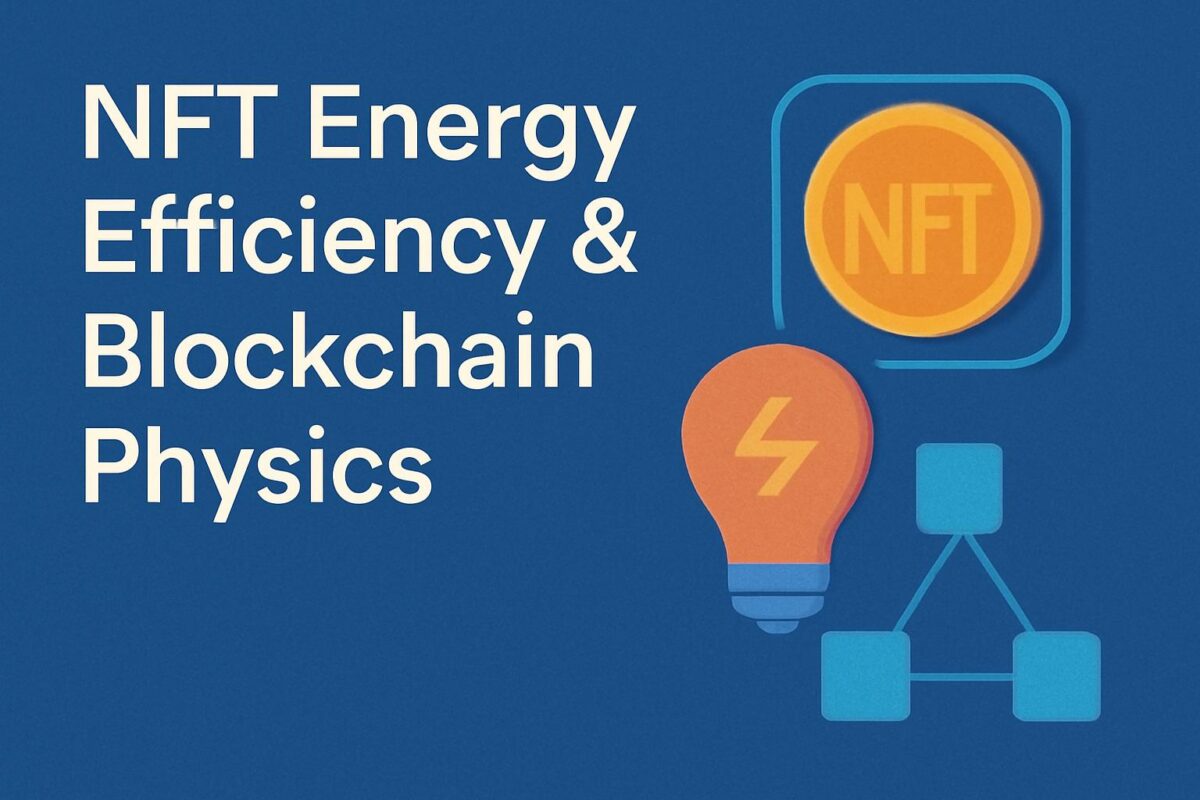NFT Energy Efficiency & Blockchain Physics

INTRODUCTION
Blockchain technology has revolutionized digital assets and decentralized systems, with NFTs (non-fungible tokens) emerging as a powerful new way to own and trade digital art, collectibles, and more. However, concerns over the environmental impact of blockchain, especially its energy consumption, have sparked debates about sustainability in the NFT ecosystem enabling NFT energy efficiency. Understanding the physics behind blockchain’s energy use is key to developing more energy-efficient NFTs and greener blockchain solutions.
The Physics of Blockchain Energy Consumption
At its core, blockchain operates as a decentralized ledger maintained by numerous nodes. The process of validating transactions, particularly in proof-of-work (PoW) blockchains like Ethereum (until recently), requires significant computational power. This power translates to real-world energy consumption, often sourced from fossil fuels, contributing to carbon emissions.
The physics challenge lies in the computational intensity of mining or validating blocks. Miners solve complex cryptographic puzzles, consuming electricity to perform trillions of calculations per second. This massive computational work ensures security and decentralization but comes at a high energy cost.
NFT Energy Efficiency: Why It Matters
NFTs depend on blockchain networks for minting, trading, and ownership verification. Each NFT transaction on a PoW blockchain involves energy expenditure proportional to the network’s demand. As NFT popularity surges, so does its associated carbon footprint, raising sustainability concerns among creators, collectors, and platforms.
Energy-efficient NFTs focus on reducing this environmental impact by adopting or supporting blockchain technologies and consensus mechanisms that require less energy without compromising security.
Sustainable Blockchains: Proof-of-Stake and Beyond
One of the most promising developments addressing blockchain energy issues is the shift from PoW to proof-of-stake (PoS) consensus mechanisms. PoS drastically reduces energy use by replacing intensive computations with validator selection based on stake ownership.
Ethereum’s transition to PoS through “The Merge” is a landmark example that cut its energy consumption by over 99%, paving the way for more sustainable NFT minting and trading.
NFT Carbon Footprint: Measuring and Mitigating Impact
Quantifying the carbon footprint of NFTs involves analyzing energy consumed during minting, buying, selling, and transferring tokens. Several projects and platforms now offer tools for NFT creators and buyers to calculate and offset the carbon emissions linked to their digital assets.
Carbon offset programs and eco-friendly blockchain infrastructure investments help neutralize the environmental impact. These initiatives promote greener NFT marketplaces and encourage responsible digital asset management.
ALSO READ: NFT Algorithms and Smart Contracts Empowering Digital Art
The Role of Blockchain Physics in Developing Energy-Efficient Solutions
Understanding energy flows and computational requirements at a physical level enables engineers to innovate more efficient blockchain designs. Advances in hardware optimization, network protocols, and cryptographic methods contribute to reducing power consumption.
For example, new cryptographic algorithms that require fewer calculations or more efficient transaction batching techniques can minimize the overall energy needed for NFT operations.
NFT Sustainability Trends and Future Outlook
As awareness of blockchain’s environmental impact grows, the NFT community is embracing sustainability as a core value. Emerging trends include:
- Green NFTs: Tokens certified as energy-efficient or carbon-neutral.
- Layer 2 Solutions: Secondary protocols that reduce transaction loads on primary blockchains, decreasing energy use.
- Cross-chain Interoperability: Connecting sustainable blockchains for broader NFT compatibility.
- Increased use of renewable energy by mining operations and data centers.
These innovations illustrate a future where NFTs and blockchain physics work hand-in-hand to create a sustainable digital economy.
Energy-Efficient Hardware and Its Impact on Blockchain Physics
Beyond consensus mechanisms, the hardware supporting blockchain networks plays a crucial role in energy efficiency. Modern Application-Specific Integrated Circuits (ASICs) and more efficient GPUs designed for mining have significantly improved performance per watt. Researchers are exploring quantum computing potentials and photonic chips that could revolutionize blockchain computations by drastically reducing energy needs.
Improved cooling systems and data center designs also contribute to energy savings, reducing the carbon footprint associated with blockchain maintenance.
The Role of Decentralized Storage in NFT Sustainability
NFTs often rely on decentralized storage systems like IPFS (InterPlanetary File System) to host their metadata and associated digital files. These systems distribute data across numerous nodes globally, which can increase redundancy and availability but may also contribute to overall energy consumption.
Innovations in storage protocols, such as proof-of-replication and proof-of-spacetime, ensure data integrity with optimized energy use. Researchers are exploring hybrid models combining on-chain verification with off-chain storage to balance sustainability with security and accessibility.
Community and Market Incentives for Sustainable NFTs
The market itself is beginning to reward sustainability. NFT collectors and creators increasingly prefer platforms that promote green practices, driving demand for energy-efficient minting and trading. Some marketplaces now include carbon impact labels on NFTs, helping buyers make informed, environmentally conscious decisions.
Blockchain projects also introduce token incentives for validators running nodes on renewable energy, encouraging a shift towards eco-friendly blockchain infrastructure.
Conclusion
The intersection of blockchain physics and NFT energy efficiency is a critical frontier in the evolving digital asset landscape. Through technological innovation, community engagement, and environmental awareness, the NFT ecosystem is moving towards sustainable practices that protect the planet while enabling digital ownership.
By embracing energy-efficient blockchains, optimizing hardware, advancing storage protocols, and incentivizing green participation, NFTs can thrive without compromising ecological responsibility.
FAQs
Q1: Why do some blockchains consume so much energy?
A1: Blockchains using proof-of-work require high computational power to maintain security, leading to high energy consumption.
Q2: How does proof-of-stake reduce blockchain energy use?
A2: Proof-of-stake replaces energy-intensive mining with a selection process based on token ownership, drastically lowering power needs.
Q3: Can NFTs be truly sustainable?
A3: Yes, by using energy-efficient blockchains, carbon offsetting, and sustainable protocols, NFTs can minimize their environmental impact.
Q4: Are there tools to measure NFT carbon footprints?
A4: Several platforms offer carbon calculators specifically for NFTs to help creators and buyers assess and offset emissions.
Call to Action (CTA)
🌿 Ready to support a greener blockchain future? Subscribe to our newsletter for the latest updates on NFT sustainability, blockchain energy innovations, and eco-friendly digital assets!